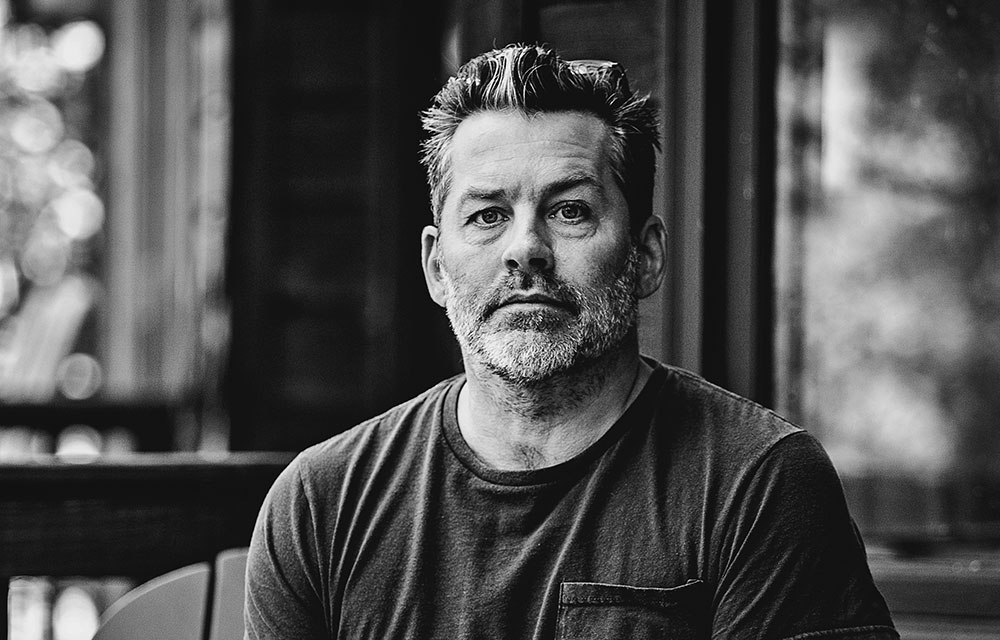By Lynell Edwards
Photo by Mickie Winters
Over the summer, while a heat dome had much of the nation in a stranglehold of humidity and 90-plus-degree temperatures, I visited author Erik Reece at his home outside Lexington, deep in the cool woods above Clear Creek near the Kentucky River community of Nonesuch. We discussed the question How shall we live?, the subject of his newest book, Utopia Drive, which chronicles his research and travels through the eastern United States to historical and current utopian communities.
For two weeks in the summer of 2014, Reece took his agent’s advice to follow up on his 25-year obsession with utopias. Reece, a Louisville native and associate professor of English at the University of Kentucky, mapped out a road trip that began with Shakertown southwest of Lexington; continued on to the ill-fated New Harmony settlement in Indiana; stopped at the modern “intentional communities” of Twin Oaks and its affiliated settlement, Acorn, both in Virginia; and ended at the Oneida community in central New York. Reece writes: “When cars and washing machines and vacuum cleaners are shared, a lot of money gets saved. When twenty people live in one house instead of four, a lot of energy and natural resources are conserved. The upshot, says Valerie (in Twin Oaks), ‘means we have a bunch of labor left over and we can do whatever we want with it.’”
What was most valuable about actually going to these places?
“Seeing that they actually exist! Or had existed. Or had vanished without a trace. It was fascinating to see what remained of a place like Oneida, which had a well-deserved reputation as a free-love community, and yet the bedrooms were incredibly cramped and uncomfortable — not exactly conducive to orgies.
“At the communities that are still going, I could actually interview the utopianists — though they would never use that moniker — and ask questions like: Are you really happy here? I could also ask myself serious questions about a place that so obviously dramatized my own socialist values on an everyday level.”
What distinguishes these communities from a cult?
“They were smart, rational, hard-working people. Their communities survived for many, many years. No one was brainwashed into joining, and anyone could leave whenever he or she chose. They were simply communities of like-minded believers. And there was no violent end to any of these communities, as you’d expect with a cult.”
The two modern “intentional communities” — Twin Oaks and Acorn — have managed to sustain, at least in part, through economic engagement with the wider world. Twin Oaks practices income-sharing and there are several Twin Oaks businesses, including a hammock-making shop. What future do you think these two places have?
“Even if its cottage industries disappeared, I think Twin Oaks could make it as a completely self-sufficient enterprise. Acorn is more volatile because it’s smaller and the members are younger. But their seed-selling business is booming and it makes up for a lot of ‘inefficiencies’ among the members. I continue to think of both Acorn and Twin Oaks as models we can learn from, worker-owned cooperatives that offer a major corrective to American corporatism.”
The takeaway from Utopia Drive is not that we all should be living off the grid or in intentional communities. But what would you advocate we learn from these examples?
“My main takeaway from these communities is the idea that you can work between the gaps. Our political system is corrupt and broken, but we don’t have to wait for the system to change or to overthrow it to do something. In Kentucky, almost everybody agrees that coal is done in this state. And so we need to be asking: What does a post-coal economy look like? At a commencement speech at UK, the poet Seamus Heaney said, ‘As long as you know there is good work to be done and are willing to do it, there’s hope.’ I would like to use this book to do that kind of advocacy.”
An excerpt from Utopia Drive:
“The most important thing we’re trying to do here,” she begins, “is create a life where we can live in accordance with our values. That’s our raison d’être, the big reason we live so differently from” — and I already know what word is coming next — “the mainstream.” Valerie speaks quickly and intensely, never losing eye contact. Her tone is one of a teacher patiently explaining a complicated piece of calculus to a tenth-grader. She is, I’m beginning to sense, the anti-Ayn Rand of Twin Oaks. “If you look at people’s life cycles,” she continues, “they’re born in a hospital that someone else owns, they go to a school that someone else runs, they work for a company that someone else owns. All of those things that happen are owned and controlled by somebody else. Regardless of your own values and how you would like to manifest them in the world, you have to fit yourself in to those organizations’ and institutions’ values, which are often not at all what your own values are. What we’re doing is birthing our babies at home, schooling our children at home, working in our own worker-owned business, and when we die, we are buried on our own land with no chemicals. Marx talks about owning the means of production. I think we take it a step further and own every aspect of our lives, and we can therefore do them in a way that manifests our values.”
This originally appeared in the October 2016 issue of Louisville Magazine. To subscribe to Louisville Magazine, click here. To find your very own copy of Louisville Magazine, click here.


